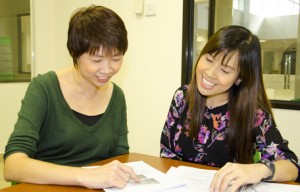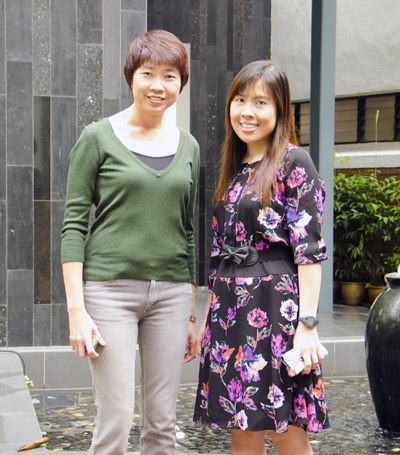Why Singapore’s English Teachers Should Embrace Singlish, Not Fight It
Is it time for Singaporean educators to embrace Singlish as a legitimate learning tool? What the Research […]
Read More
When teachers collaborate with academic researchers, both parties get to learn from one another. This helps to broader their professional horizons.
Sometimes, when a researcher invites teachers to be part of a research project, they may wonder how this would help them in their teaching work. But a close collaboration between teachers and researchers can benefit both parties and enhance their knowledge in each other’s fields. It might even present opportunities for the teacher to explore and improve their teaching and professional development.This is just what happened when Ms Tay Su Lynn, the Subject Head of Physics at Catholic Junior College, was connected with a researcher from NIE.

Jennifer Yeo (left) and Su Lynn feel that a teacher-researcher collaboration has brought about benefits for both of them
Dr Jennifer Yeo from NIE and Su Lynn were first introduced in 2009, when Su Lynn helped Jennifer facilitate a group of students for a research project. They worked closely and had several discussions about the difficulties those students were having.
“I remember one of the questions that Su Lynn brought up was whether there was a structure to teach the students to construct explanations, or to answer qualitative questions,” says Jennifer.
When she looked at findings from another project of hers to find out how students develop an understanding of abstract concepts, Jennifer saw that constructing explanations was something that students struggle with in the A-Levels Physics exam.
When Su Lynn went to the US for a modelling instruction workshop at the Arizona State University (see box story “Modelling Approach in Teaching” below) and came back to share with Jennifer what she had learned, things slowly fell into place. “All of that gave me an idea,” recalls Jennifer.
She noted that the modelling pedagogy Su Lynn is interested in has a strong explanatory component. “I see how my interest in students’ explanation can fit well with her pedagogy,” she explains.
They decided to work together and embarked on a research project that uses the modelling approach to help students construct better explanations.
 Su Lynn and Jennifer both think that the collaboration brought about benefits for both of them.
Su Lynn and Jennifer both think that the collaboration brought about benefits for both of them.
Su Lynn notes that Jennifer acts as a partner and observer in her classroom. Jennifer would listen in to students’ conversations to find out whether they have any problems following the lesson while Su Lynn is busy teaching the class.
“It’s good to understand what struggles the students have during the lesson itself, and how to assist them,” says Su Lynn. “When I conduct a lesson, Jennifer will observe and give me feedback, which I try to address straight away.”
Besides feedback, Jennifer also lends a hand in lesson planning by suggesting teaching ideas and strategies to Su Lynn.
Jennifer shares that her perspective of how things work in the classroom may differ from Su Lynn’s. “As an academic, a lot of our approaches are based in research literature,” she observes. “We are not like teachers who can try something immediately. So it’s good working with Su Lynn because she is able to tell me if something is just not feasible in the classroom.”
But Su Lynn appreciates the research literature and theoretical perspectives that Jennifer brings to her attention, as these broaden her horizons as a teacher. “Jennifer knows the perspectives outside my classroom which I would otherwise not have known,” she remarks.
“It’s really helpful because it takes time to read all this, and while I do some, I can’t be as well-informed as she is. With her knowledge, I can try to align what I’m doing with research evidence to have a clear rationale of why I’m doing certain things in the classroom.”
In working with Su Lynn, Jennifer not only gets to carry out her research study in a classroom and collect relevant data, but also gains a better understanding of challenges that teachers may face.
In this way, she gains contextual knowledge that will help in her future research collaborations with schools.
For beginning teachers, you can learn from others. Then you can leverage each other’s strengths and hopefully you will be a bit braver to want to try out research.
– Tay Su Lynn, Catholic Junior College
Besides improving her teaching pedagogy, this research collaboration has also opened up more professional development opportunities for Su Lynn. The duo have been working together to conduct seminars for other teachers.
“We ran a workshop for Lead and Senior Teachers at the Academy of Singapore Teachers,” Jennifer says, adding that they will be doing another sharing session with A-Level Physics teachers soon.
On top of that, Su Lynn is also embarking on a Masters programme. She is incorporating her research interest into her studies by looking at the teacher’s pedagogical moves in the modelling-based classroom for her dissertation. Jennifer works with her here as well, as her supervisor.
“What I hope is to be able to make it more explicit the things that could help students in their learning,” explains Su Lynn. “I hope I can assist other teachers who are also trying to explore these areas and trying to engage students more as well.”
In Su Lynn’s case, working with an academic researcher has opened more doors to opportunities for professional and personal development. And having a passion for that area of research keeps her going. “I see the value in this research, and that’s why I’m doing it.”